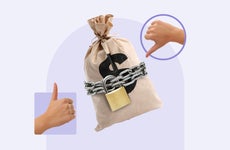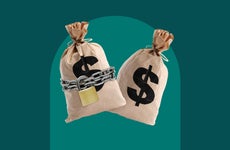Secured vs. unsecured business line of credit

The Bankrate promise
At Bankrate we strive to help you make smarter financial decisions. While we adhere to strict , this post may contain references to products from our partners. Here's an explanation for .
Key takeaways
- Secured lines of credit require collateral
- Unsecured lines of credit do not require collateral, but a personal guarantee may be needed
- Consider business needs, qualifications, credit score and assets when choosing a line of credit
To cover short-term expenses, manage cash flow or explore growth opportunities, business owners may open a business line of credit. You can draw on funds up to the credit limit and repay to replenish the line.
Lenders offer two types of business lines of credit: Secured and unsecured. A secured line of credit can have more flexible requirements and lower interest, but an unsecured line doesn’t require collateral, making it appealing to businesses with little to no assets.
Compare secured vs. unsecured lines of credit
| Secured lines of credit | Unsecured lines of credit |
|---|---|
| Requires collateral, such as property or other assets of significant value. | Collateral is not required, so approval is largely based on the business owner’s creditworthiness and income. |
| The lender can seize business assets used as collateral if borrowed funds are not repaid. | A personal guarantee may be required, making the business owner personally responsible for repaying the line of credit if the business cannot keep up with payments. |
| Typically, lower interest rate | Typically, higher interest rate |
| Higher credit limit if you can provide enough collateral to secure it | Lower credit limit |
Secured business lines of credit
If you choose a secured business line of credit, you agree to offer up assets to repay the loan if you default. Common types of business collateral include vehicles, real estate, inventory, or equipment. Your collateral’s total value should match the borrowed amount so the lender can fully recoup the funds.
Typically, with a secured business line of credit and other secured business loans, you’ll receive lower interest rates and higher borrowing limits since your lender assumes minimal risk.
Secured business line of credit pros
- Lower interest rate: Loan approval isn’t based solely on your credit score or income. Your assets’ value matters too. Lenders may feel more comfortable charging lower interest rates.
- Higher loan amount: Depending on your assets’ value, you can access a higher loan amount than you would with an unsecured business loan.
- Increases odds of approval: Since the loan is secured with collateral equal to the loan’s value, lenders are more likely to approve borrowers with poor or fair credit.
Secured business line of credit cons
- Loss of collateral: If the borrowed funds are not repaid, the lender can seize the assets, which may harm the business if the asset is vital to its operation.
- Lengthy application process: Lenders have to get the collateral appraised to ensure it is of value, and this can slow down the process of securing the loan.
- Risk of overspending: A high credit limit can tempt you to spend more than you can afford, leaving you struggling to repay what you’ve borrowed.
Unsecured business lines of credit
The biggest difference between a secured and unsecured business line of credit is that collateral isn’t required. But even with an unsecured line of credit, you’re not completely off the hook if you don’t repay what you borrow. Most lenders require a personal guarantee from the business owner.
Qualifying for an unsecured business line of credit may be challenging, especially when you are a startup or have little to no business credit. You may have better luck getting approved with an online lender, but you risk paying higher interest.
Unsecured business line of credit pros
- No risk to business assets: With unsecured loans, there’s no collateral for the lender to seize if you default.
- Faster funding timeline: Underwriting is typically faster with unsecured loans because the lender can skip the collateral appraisal step.
Unsecured business line of credit cons
- Harder to qualify: Because lenders can’t offset their risk by requiring collateral, they’ll typically set other creditworthy requirements higher.
- Higher interest rates: Unless you have truly outstanding credit, you’ll likely see higher
- May require a personal guarantee: With a personal guarantee, you may lose your own assets instead of the business’s if you hit hard times and can’t repay the loan.
Secured vs. unsecured line of credit: Which is better?
If you’re uncertain about which type of line of credit is better, start by assessing the needs and qualifications of your business. Consider how you will use the business line of credit, how much you need to borrow and your assets. And weigh your business credit score, income, annual revenue and other important financial information that lenders may use to evaluate your eligibility.
You should find that either unsecured or secured is the better match for your needs and qualifications.
Once you’ve decided, compare the individual loans available to you. Evaluate the maximum credit limit, interest rates, fees, draw period length and repayment terms.
Alternatives to business lines of credit
Business owners may want to explore financing options beyond business lines of credit to find an alternative more tailored to their business needs.
- Business credit cards: Business credit cards provide businesses with a revolving line of credit to access as needed. The limit is often lower than what you’d get with a business line of credit, so it is ideal for smaller business expenses.
- Term loan: With a term loan, businesses are given a lump sum to cover various business expenses, including payroll, inventory or the purchase of equipment or real estate. Loan amounts vary by the lender, loan type and business qualifications, but funds are repaid over time, plus interest and fees, according to a specific schedule.
- Crowdfunding: Crowdfunding allows businesses to raise capital through contributions made by individuals and businesses. Crowdfunding has various types, including donation, debt, reward, or equity. Depending on the type, funds are nonrepayable, contributors are repaid, or contributors receive a reward or equity in the business.
- Grants: Businesses looking to avoid taking on debt can benefit from a business grant. Since these funds are nonrepayable, there’s no financial burden, meaning little to no risk. However, this does make the approval for grants competitive.
- Merchant cash advance: Similar to a business line of credit, a merchant cash advance is ideal for businesses with fluctuating revenue. Businesses get immediate access to funds, and it is based on a percentage of their credit card sales.
The bottom line
Choosing between a secured and unsecured line of credit is the first step to getting a business line of credit. Secured business lines of credit tend to offer higher credit lines and lower interest rates, but an unsecured line of credit doesn’t require collateral. Carefully consider the needs and qualifications of your business to help you decide which is the better fit.
Frequently asked questions
-
A business line of credit can be secured or unsecured. Lenders may offer both unsecured and secured business lines of credit or only one, depending on their business loan products.
-
The choice between a secured and unsecured line of credit depends on the business’s needs, qualifications, credit score and assets.
-
The required credit score of a secured business line of credit varies based on the lender, but businesses may be eligible with a minimum credit score of 500.
Related Articles



